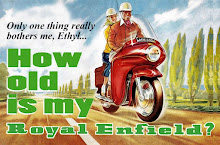 |
| It was a case of Beauty and the Beast. |
Royal Enfield once manufactured a motorcycle so ugly that even posing a pretty girl next to it wouldn't sell it.
One advertisement showed the girl sitting on the Royal Enfield Model Z Cycar as a uniformed RAC officer gave her directions to her destination.
The Model Z Cycar was a sales bust. But, funnily enough, a later look-alike motorcycle marketed by Velocette sold in numbers.
The Cycar and the Velocette LE look so much alike you couldn't pick one or the other out of a police line-up. So why was the Velocette such a success (production ran for more than 20 years)?
Well, for one, Velocette didn't try to peddle its ugly ducklings to pretty girls. It sold them to the police.
 |
| Same idea, from Velocette. But theirs was a success. |
Paul D'Orleans of The Vintagent website, picked a Velocette LE as one of the "Top Ten" motorcycles scheduled for the Mecum Las Vegas Auction Jan. 27-31, 2026.
You've gotta know that he considered his choice — um — a bit controversial. My God: it's a boxy, underpowered, side-valve flat twin, and, what's worse it was the motorcycle that spoiled Velocette's reputation for building gorgeous motorcycles.
"Despite their popularity with the cops, this is the design that sank a great company," he wrote.
"They knew a people’s motorcycle would someday conquer the world, but that was the Honda C100, not a strange little water-cooled flat twin. "
The Velocette LE (for "Little Engine") up for auction is a 1970 model.
 |
| Not pretty, but it had its points. |
Royal Enfield's own experiment with building a utilitarian people's motorcycle didn't even last until World War II. Only about 1,500 were built between 1931 and 1936.
Naturally, the Royal Enfield of 1931 wasn't even as sophisticated as the 1970 Velocette. The Royal Enfield had a 148cc two-stroke single cylinder motor, with three-speed hand shift.
But its frame was a clever single steel pressing, "offering complete protection from oil, grease and mud without sacrificing accessibility." Equipped with standard leg shields, it kept the icky stuff off a lady's skirt.
On the other hand, she was bound to get her hands oily using the gas cap to measure the correct amount of two-stroke oil to add to the mix.
Jorge Pullin has detailed information about the Cycar on his blog My Royal Enfields.
Interestingly, he has also tracked ad photos of the "lady in the fur coat" and her Cycar as Royal Enfield ran her around town posing with it!
Follow along as Jorge stalks the young woman from here.
 |
| Yes, they even made her wash it. |































